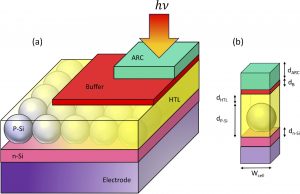Abstract
In this paper, a new architecture comprising silicon nanoparticles inside a hole transport layer laid on a thin silicon layer is proposed to develop ultrathin film solar cells. Using generalized Mie theory, a fast analytical approach is developed to evaluate the optical absorption of the proposed structure for various geometries, polarizations and angles of incidence. The analytical results are verified through comparison with full-wave simulations, illustrating a reasonable agreement. The electrical performance of a distributed silicon nanoparticle solar cell is determined for selected configurations. To be able to predict the light-trapping in a solar cell comprising randomly distributed nanospheres, a new technique based on probability theory is developed and validated through comparison with the simulation results. Both analytical and numerical results show that the excited Mie resonant modes in the proposed structure lead to a significant enhancement in both absorption and the photo-generated current, in comparison to a conventional silicon solar cell with an equivalent volume of the active layer. In the case of random distributions, other advantages, including the simple fabrication process, indicate that the cell is a promising structure for ultrathin photovoltaics.

link:
https://opg.optica.org/oe/fulltext.cfm?uri=oe-29-18-28037&id=457250